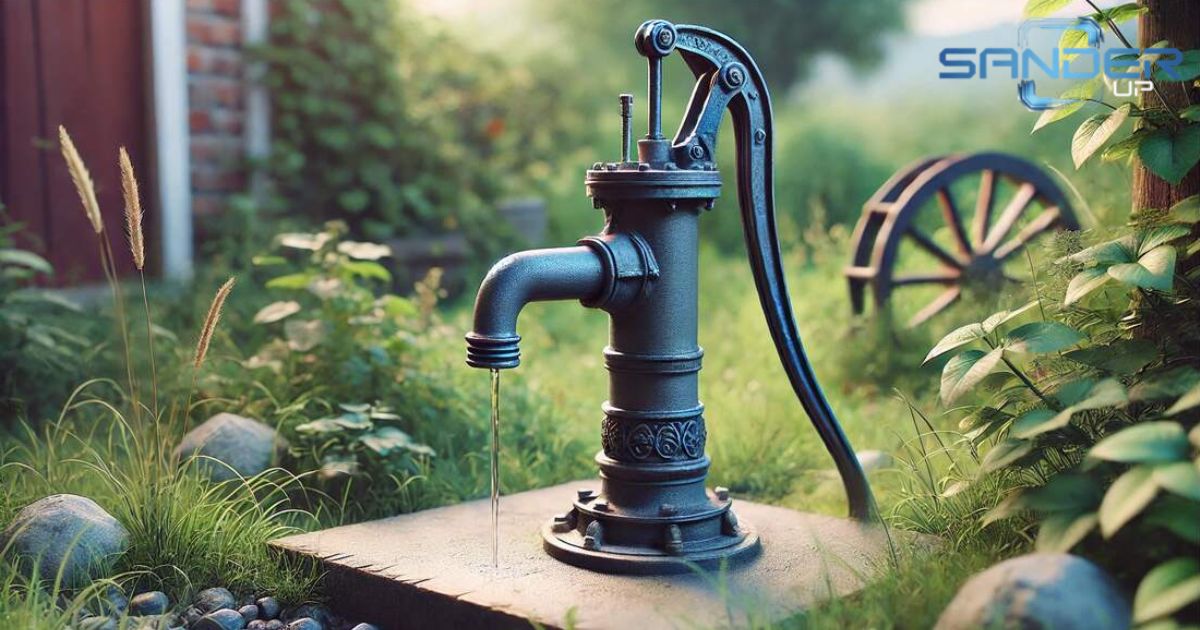A hand pump is a mechanical device used to move liquids or gases by manual operation. It consists of a handle, a cylinder, and a piston or diaphragm. By manually operating the handle, users create a vacuum or pressure that moves the fluid or gas through the pump and out through an outlet.
Hand pumps are used for transferring fuel, water, or other fluids when power sources are not available. They are versatile tools commonly found in various applications, including:
- Water Wells: Used to draw water from underground sources.
- Automobiles: For transferring fuel or other fluids.
- Inflation: To inflate tires, sports equipment, and other inflatable items.
- Agriculture: For pumping water for irrigation systems.
Hand pumps are favored for their simplicity and reliability. They require no electricity or external power sources, which makes them helpful in emergencies or in locations where power is not readily available.
How Does a Manual Water Pump Work?
A manual water pump is designed to draw water from a well or other source without relying on electricity or complex machinery. Here is a simple breakdown of how it operates:
- When you operate the handle of the manual water pump, it creates a mechanical motion that moves a piston or plunger inside the pump cylinder.
- As the piston moves up, it creates a vacuum inside the pump chamber. This vacuum pulls water up from the well or source into the pump.
- The water moves through a series of valves and pipes. One-way valves prevent the water from flowing back down the well, ensuring that the water is only pushed upward.
- Once the piston reaches the top of its stroke, the water is forced out of the pump spout or nozzle and can be collected in a container or used directly.
Types of Hand Pumps
Here are many types of Hand Pumps and there advantages:
1. Lift Pumps
Lift pumps are the most common type of hand pumps. They are designed to draw water from shallow depths, typically up to 25 feet. The pump works by creating a vacuum that lifts water into the pump chamber. The mechanism inside involves a piston or plunger that moves up and down within a cylinder. When you operate the pump handle, the piston moves, creating suction that pulls water upwards.
- Advantages: Lift pumps are easy to use and maintain, making them ideal for small-scale applications. They are also affordable and widely available.
- Best For: These pumps are best suited for shallow wells, rain barrels, ponds, and other water sources close to the surface. They’re perfect for providing water in homes or gardens where the water source isn’t too deep.
2. Force Pumps
Force pumps are more powerful than lift pumps and are designed to draw water from greater depths, often up to 200 feet or more. They operate using a piston that pushes water through a narrow pipe, creating pressure. This pressure allows the water to be delivered to a higher elevation or even into a pressurized system, such as a storage tank.
- Advantages: Force pumps are effective for deep wells and can supply water to elevated storage tanks or pressurized systems. They are more robust than lift pumps and can handle deeper water sources.
- Best For: These pumps are ideal for deep wells, hilly areas, and locations where you need to pump water to a higher place, like an elevated tank.
3. Siphon Pumps
Siphon pumps work by utilizing the principle of siphoning to move liquids. They create a vacuum that causes the liquid to flow upward and then downward through a siphon tube. Siphon pumps are often used to transfer liquids from one container to another, such as when you need to drain a tank or move water between containers.
- Advantages: Siphon pumps have a simple design with no moving parts, making them easy to operate and maintain. They are cost-effective and versatile.
- Best For: These pumps are best used for transferring water or other liquids between containers, draining tanks or pools, and similar tasks.
4. Diaphragm Pumps
Diaphragm pumps use a flexible diaphragm that moves back and forth to create a pumping action. This movement changes the volume within the pump chamber, drawing water in and then forcing it out. Diaphragm pumps are particularly useful because they can handle thicker, more viscous fluids, and can even pump water with solid particles in it.
- Advantages: Diaphragm pumps can handle dirty or muddy water, making them durable and versatile for more challenging pumping situations. They’re also good for pumping liquids with a higher viscosity.
- Best For: These pumps are best suited for agricultural applications, floodwater management, slurry pumping, and situations where the water may be contaminated.
5. Pitcher Pumps
Pitcher pumps are traditional hand pumps commonly found in rural areas. They are typically mounted on a base over a well or water source. You operate the pump by moving the handle up and down, which creates suction to draw water into the pump and out through a spout.
- Advantages: Pitcher pumps are easy to install and use. They don’t require electricity, making them ideal for remote areas or emergency situations.
- Best For: These pumps are great for small-scale water extraction, such as garden irrigation or providing water to rural homes.
6. Rotary Pumps
Rotary pumps work using a rotating mechanism that moves liquid through the pump. Common types of rotary pumps include gear pumps and vane pumps. These pumps are well-suited for moving thick liquids, such as oil or syrup, but can also be used for water.
- Advantages: Rotary pumps are efficient at pumping thick or sticky liquids. They are durable and reliable, making them a good choice for industrial applications.
- Best For: These pumps are ideal for industrial settings, oil extraction, and situations where you need to move thick or sticky fluids.
7. Double-Acting Pumps
Double-acting pumps have a unique design where the piston works in both directions, meaning water is pumped both when the handle is pulled up and when it’s pushed down. This design doubles the efficiency of the pump, as it moves water on both the upstroke and the downstroke.
- Advantages: Double-acting pumps are highly efficient and provide a continuous flow of water, making them very effective for tasks that require a steady supply.
- Best For: These pumps are best for applications requiring a steady, consistent flow of water, such as garden irrigation or providing water for livestock.
8. Jack Pumps
Jack pumps are typically used for extracting oil but can also be adapted for deep well water pumping. They use a rocking motion to drive a piston up and down, which draws liquid to the surface. Jack pumps are powerful and can handle large volumes of liquid from significant depths.
- Advantages: These pumps are capable of pumping from very deep sources and handling high volumes of liquid. They are robust and reliable.
- Best For: Jack pumps are best for oil extraction, deep well water pumping, and large-scale liquid extraction in industrial settings.
9. Chain Pumps
Chain pumps consist of a chain with circular discs attached at regular intervals, which run through a pipe. As the chain is rotated, the discs move through the pipe, lifting water upward and out of the pipe’s top. These pumps are often used in agricultural settings, particularly for irrigation.
- Advantages: Chain pumps can lift water from significant depths and move large volumes of water. They are durable and effective for continuous use.
- Best For: These pumps are ideal for irrigation, water supply in rural areas, and any situation requiring a steady flow of water.
10. Rope Pumps
Rope pumps are similar to chain pumps but use a rope instead of a chain, with small discs or knots that lift water as the rope is pulled through a pipe. They are inexpensive and easy to maintain, making them popular in developing countries.
- Advantages: Rope pumps are low-cost, simple to operate, and easy to repair with locally available materials. They are a practical solution for basic water needs.
- Best For: These pumps are best for rural water supply, irrigation, and low-cost water lifting solutions in areas with limited resources.
11. Hydraulic Ram Pumps
Hydraulic ram pumps use the energy from a large amount of water falling a short distance to lift a smaller amount of water to a higher elevation. These pumps are unique because they require no external power source. They operate using the kinetic energy of flowing water.
- Advantages: Hydraulic ram pumps don’t require fuel or electricity, making them environmentally friendly and cost-effective. They are durable and require minimal maintenance.
- Best For: These pumps are ideal for lifting water in hilly or mountainous areas and providing an off-grid water supply.
12. Bucket Pumps
Bucket pumps are one of the simplest types of hand pumps. They involve lowering a bucket with a valve at the bottom into a well, filling it with water, and then pulling it back up. The valve allows water to enter the bucket but prevents it from escaping as the bucket is raised.
- Advantages: Bucket pumps are extremely simple, with no moving parts and no maintenance required. They are a very low-tech solution.
- Best For: These pumps are best suited for shallow wells, emergency water supply, and situations where a low-tech, easy-to-use pump is needed.
13. Progressive Cavity Pumps
Progressive cavity pumps use a helical rotor that rotates within a helical stator. As the rotor turns, cavities form between the rotor and the stator, which move the liquid through the pump. These pumps can handle viscous liquids and liquids with suspended solids.
- Advantages: Progressive cavity pumps are capable of handling thick liquids, providing a gentle pumping action with minimal pulsation.
- Best For: These pumps are ideal for industrial applications, pumping slurries or thick fluids, and use in the food and beverage industries.
14. Treadle Pumps
Treadle pumps are foot-operated pumps that use a pedal mechanism to pump water. The user stands on two pedals and pushes them up and down, which drives the pump. These pumps are often used in agricultural settings for small-scale irrigation.
- Advantages: Treadle pumps allow for hands-free operation and are excellent for irrigating small farms. They are easy to use and require minimal training.
- Best For: These pumps are best for small-scale irrigation, water supply in developing regions, and situations where manual labor is readily available.
15. Peristaltic Pumps
Peristaltic pumps use a rotating mechanism that squeezes a flexible tube or hose, creating a vacuum that draws liquid through the tube. These pumps are often used for precise dosing of liquids, including in medical applications.
- Advantages: Peristaltic pumps provide a gentle pumping action that’s ideal for handling delicate or shear-sensitive fluids. They also prevent contamination of the fluid being pumped.
- Best For: These pumps are ideal for medical applications, chemical dosing, and situations requiring precise control of fluid flow.
16. Centrifugal Hand Pumps
Centrifugal hand pumps use a rotating impeller to move water by converting rotational kinetic energy into hydrodynamic energy. Although not as common for manual use, some designs can be operated by hand.
- Advantages: Centrifugal hand pumps are capable of handling large volumes of water, making them suitable for various applications.
- Best For: These pumps are best for agricultural irrigation, water transfer, and situations where high flow rates are needed.
17. Bilge Pumps
Bilge pumps are specifically designed to remove water from the bilge of a boat. Hand-operated bilge pumps are often used in marine settings to manually remove water that has accumulated in the boat’s hull.
- Advantages: Bilge pumps are easy to operate and essential for boat safety. They are portable and reliable.
- Best For: These pumps are best suited for marine applications, emergency water removal, and use in small boats.
Criteria for Choosing a Hand Pump
Choosing the right hand pump does not have to be complicated. By considering a few key factors, you can find a pump that’s easy to use, durable, and fits your needs perfectly. Here is a quick guide to help you choose:
- Fluid Type: Know what you’re pumping. Different pumps handle different fluids like water, oil, or chemicals. Make sure the pump material is safe for the fluid you’ll be using.
- Flow Rate: This is how fast the pump can move the fluid. If you need to pump a lot quickly, go for a higher flow rate. For smaller tasks, a lower flow rate might be easier to manage.
- Pump Type: Hand pumps come in types like piston, diaphragm, and rotary. Piston pumps are strong and good for thicker fluids, while diaphragm pumps work well with harsh liquids.
- Portability: If you need to move the pump around, consider its size and weight. Choose a pump that’s easy to carry but still powerful enough for your needs.
- Durability: Look for pumps made from tough materials like stainless steel or strong plastic, especially if you’ll be using them in rough conditions.
- Ease of Use: Pick a pump that’s simple to operate. Features like comfortable handles and easy maintenance make a big difference.
- Cost: Don’t just go for the cheapest option. A slightly more expensive pump might last longer and work better, saving you money over time.
By focusing on these points, you can find a hand pump that’s easy to use, durable, and just right for your needs.
Installing a Hand Pump Water Well: A Step-by-Step Guide
Installing a hand pump water well is a practical way to ensure a reliable supply of fresh water on your property. Whether for emergency use, gardening, or as a backup source, having a hand pump well can be invaluable. This guide will walk you through the process, making it easy to follow even for beginners.

Step 1: Finding the Right Spot
The first step in installing your hand pump water well is to choose the right location. You’ll want to find a spot where the water table is relatively close to the surface, typically within 25 to 30 feet deep. To determine the depth, you might need to consult local water records or seek advice from a well-drilling professional.
Ensure the location is clear of any potential contaminants. It is important to keep the well at least 100 feet away from sources of pollution such as septic tanks, livestock pens, or chemical storage areas. This distance helps protect the water quality from possible contamination.
Consider accessibility as well. Choose a spot that’s easy to get to for both maintenance and daily use. Avoid areas that are difficult to access or prone to flooding.
Step 2: Getting Your Tools and Materials Ready
Before starting the installation, make sure you have all the necessary tools and materials:
- Allen Wrench Set: Includes sizes 1/4”, 3/16”, and 5/32”. These are essential for tightening various bolts and screws during the installation.
- Channel-lock Pliers: You’ll need two of these, large enough to grip a 1.75” diameter pipe securely. They are crucial for holding and turning pipes during assembly.
- Vise Grip Wrenches: Two vise grip wrenches are needed to firmly hold parts in place and provide leverage when tightening.
- Teflon Tape: This is used to seal pipe threads and prevent leaks in the connections.
- Diluted Bleach Solution: Used to sanitize the well components before installation, ensuring that your water supply remains clean and safe.
- Wire Cutters or Strippers: Required if you are installing the hand pump next to a submersible well pump, these tools help in managing any electrical wiring involved.
- Permatex Anti-Seize Lubricant: A small tube is sufficient for applying to threads and other parts to prevent seizing and make future maintenance easier.
- Loctite Thread Locker (Medium Strength): This thread locker is used to secure bolts and fittings, ensuring they stay tight over time without loosening.
Having these tools and materials ready before starting the installation will make the process smoother and more manageable.
Step 3: Digging the Well
Start by digging a pilot hole to provide a starting point for the well casing. This hole should be around 10 feet deep. Insert the well casing, which can be made of PVC or steel, into the pilot hole. This casing prevents the sides of the hole from collapsing and keeps the well clean.
Continue digging until you reach the water table. Make sure the well pipe is long enough to extend into the water. As you dig deeper, periodically check the depth to ensure you’re reaching the necessary level. Insert the pipe into the casing as you go to ensure it reaches the water table properly.
Step 4: Installing the Well Screen
Once you have reached the water table, it’s time to install the well screen. Attach the screen to the bottom of the well pipe. This screen is crucial for filtering out sediment and preventing debris from entering the well. Lower the pipe and screen assembly into the well casing carefully, making sure the screen is seated properly at the bottom.
Step 5: Assembling the Hand Pump
With the well screen in place, you can now assemble the hand pump. Start by following the instructions provided in your hand pump kit. Typically, this involves attaching the pump to the top of the well pipe and securing it with the provided fittings.
Use pipe sealant on all connections to ensure they are watertight. Once the pump is securely attached, test it by pumping the handle several times to see if water flows smoothly. If you experience any issues with water flow, recheck the connections and ensure the well screen is not blocked.
Step 6: Securing and Finishing Up
After the pump is assembled and working, it’s time to secure the well and finish up the installation. Begin by backfilling around the well casing with gravel and sand. This material will help stabilize the well and provide additional filtration to keep the water clean.
Next, place a protective well cap or cover over the top of the well. This cover is essential for keeping out dirt, debris, insects, and small animals, ensuring your water supply remains uncontaminated. Once the cover is in place, give the pump a final test to ensure everything is functioning correctly.
Step 7: Maintenance Tips
To keep your hand pump water well in good condition, regular maintenance is key. Frequently inspect the pump and connections for leaks and address any issues promptly. Clean the well screen periodically to remove debris and maintain water quality. Inspect the well casing for signs of damage or wear, and repair or replace it as necessary. In colder climates, insulate the pump and casing to prevent freezing during winter.
FAQ’s
What is a hand pump used for?
A hand pump is used to manually lift and move fluids, such as water, from a well or other source. It operates by creating a vacuum or mechanical pressure to draw the liquid through a pipe or tube and discharge it through a spout.
Is hand pump water safe to drink?
Hand pump water can be safe to drink if the source is clean and the water is properly tested and treated.











